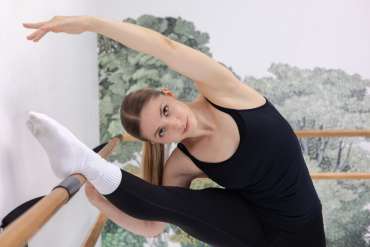Plyometrics is a powerful training method designed to enhance explosive strength and increase vertical jump height, making it a popular choice for athletes, dancers, and anyone looking to improve their performance in sports and fitness. At its core, plyometric exercises involve quick, dynamic movements that rapidly stretch and contract muscles, training the body to generate maximum force in the shortest time possible. This results in improved muscle power, faster movements, and greater agility. Whether you’re aiming to jump higher in basketball, perform more powerful leaps in dance, or just want to increase your overall athletic performance, plyometric training can offer remarkable benefits. However, it’s essential to approach plyometric exercises gradually, ensuring that your body is properly conditioned and prepared for the intense demands of these movements. In this article, we will explore the science behind plyometrics, its benefits, and how you can incorporate effective plyometric exercises into your training routine to achieve better results and reduce the risk of injury.
What Is Plyometrics?
Plyometrics is a specialized form of training often referred to as “jump training.” This technique is designed to enhance muscular power, explosiveness, and overall athletic performance. Plyometric training utilizes dynamic, high-intensity exercises that challenge the body by rapidly stretching and then contracting muscles in quick succession. These exercises focus on increasing the efficiency and strength of the muscles through repetitive cycles of stretching and contracting.
At its core, plyometric training aims to maximize the body’s ability to generate force in a short amount of time. This is particularly beneficial for athletes in sports requiring quick, explosive movements, such as basketball, football, or track and field. For example, exercises like box jumps, squat jumps, and bounding require the muscles to quickly stretch (eccentric phase) and then rapidly shorten (concentric phase), stimulating muscle fibers in a way that enhances their power output.
One of the most notable benefits of plyometric training is its ability to strengthen muscles, particularly the large muscle groups like the quadriceps, glutes, hamstrings, and calves. By conditioning these muscles through dynamic resistance, plyometrics can increase the vertical jump, improve sprinting speed, and elevate overall agility. Additionally, plyometrics helps reduce the impact forces on joints, such as the knees, by training muscles to absorb and dissipate the force more effectively. This not only improves performance but also lowers the risk of injury, making plyometric training an essential component for many athletes.
In short, plyometrics is not just about jumping or hopping; it’s a full-body workout method that improves the body’s functional strength, coordination, and explosiveness, ultimately leading to greater athletic performance and reduced injury risks.
What Are the Benefits of Plyometrics?
Plyometrics offers a wide range of benefits, particularly for dancers who are looking to enhance their performance and strength. Many dancers have come to recognize the significant advantages of incorporating plyometric exercises into their regular training routines. These exercises not only help dancers increase their explosive power but also contribute to better muscle strength, agility, and joint protection. Given the dynamic nature of dance, which often involves jumping, leaping, and sudden changes in direction, plyometrics can be an essential tool for elevating a dancer’s capabilities.
One of the key benefits of plyometric training is its ability to improve vertical jump height. In dance, especially in styles like ballet, contemporary, or jazz, the ability to jump higher and land more gracefully is crucial. Plyometric exercises, such as squat jumps, tuck jumps, and plyometric lunges, focus on developing explosive leg strength and power, which directly translates to improved vertical jump performance. As dancers practice these exercises, they train their muscles to contract with greater speed and force, allowing them to push off the ground more powerfully and achieve greater heights in their leaps.
Another major benefit of plyometrics is the increase in overall muscle strength. These exercises target key muscle groups used in dance, such as the quadriceps, hamstrings, calves, and glutes, helping to develop greater strength, endurance, and control over movements. Strengthening these muscles allows dancers to execute more powerful and controlled movements, enhancing their technical ability and performance in various routines.
Furthermore, plyometric training helps protect the joints by improving the body’s ability to absorb impact. In dance, especially during landings or rapid changes in direction, the joints—particularly the knees, ankles, and hips—are exposed to significant stress. Plyometrics help condition the muscles around these joints to absorb and disperse the impact more efficiently, reducing the risk of injury. This is crucial for dancers who perform high-impact routines, as it allows them to land more safely and with less strain on their bodies.
Plyometrics also contributes to overall agility and coordination. By incorporating exercises that require quick, explosive movements, dancers develop faster reflexes, improved balance, and greater overall control of their body. This enhanced coordination makes it easier for dancers to execute complex choreography, maintain stability during fast-paced movements, and respond swiftly to changes in their routine or performance.
In essence, the benefits of plyometrics for dancers extend beyond just improving jumps. By increasing explosive power, muscle strength, joint protection, and agility, plyometric training helps dancers perform at their best while minimizing the risk of injury. It is a powerful tool for dancers looking to elevate their technique, push their limits, and reach new heights in their dance practice.

How Does Plyometrics Work?
Plyometrics is designed to enhance the body’s ability to generate maximum force in the shortest amount of time possible. This method focuses on training the muscles and nervous system to work together more efficiently, allowing individuals to perform explosive movements with greater power and speed. By incorporating rapid and dynamic exercises into a training routine, plyometrics teaches the body to react quickly and generate force at a faster rate, which is especially beneficial in sports and activities that require sudden bursts of energy, such as jumping, sprinting, or changing direction.
At the core of plyometric training is the concept of the stretch-shortening cycle (SSC), which involves a rapid stretching phase followed by an equally rapid shortening phase. This cycle is key to improving explosive power. For example, when performing a jump, a muscle is initially stretched as the body lowers into a squat position. This stretch creates potential energy within the muscle fibers. As the muscles rapidly shorten to push off the ground, the stored energy is released, resulting in a more powerful jump. This process not only makes the movement more efficient but also helps to increase the force produced by the muscles involved.
The efficiency of plyometrics lies in its ability to condition both the muscles and the nervous system. Through the practice of fast-paced, high-intensity movements, plyometrics trains the body’s neuromuscular system to react more quickly and with greater force. This means that the body learns to produce more power in a fraction of a second, which can translate to improvements in performance, such as a higher vertical jump or quicker acceleration in sprints. The nervous system becomes more adept at firing the necessary muscle fibers for explosive movements, and over time, this adaptation leads to enhanced overall strength and power.
To properly execute plyometric exercises, it is important to move through a full range of motion as quickly as possible. This means engaging in movements that require rapid stretching and then immediate contraction. The stretch, which occurs as the muscles lengthen before a jump or explosive movement, is crucial for activating the muscles and improving their capacity to generate power. The faster the stretch occurs, the more powerful the muscle contraction will be. This results in increased force and speed, both of which are essential for athletic performance and physical fitness.
In summary, plyometrics works by training the muscles to react more quickly and powerfully through the stretch-shortening cycle. The key to this training is moving rapidly through a full range of motion, stretching the muscles, and then immediately contracting them to generate maximum force. As the nervous system adapts to these high-intensity movements, it becomes more efficient at producing explosive power, leading to improved performance in a variety of athletic activities. Through consistent practice, plyometrics can help athletes and fitness enthusiasts increase their speed, strength, and overall explosive ability.
Can Plyometrics Cause Injury?
While plyometric training offers numerous benefits, such as improving explosive power, strength, and agility, it is important to recognize that it does come with an increased risk of injury, particularly for individuals who are not adequately prepared for the intensity of these exercises. This is especially true for dancers or athletes who may not have built up sufficient strength and conditioning before attempting such high-impact training. The fast, dynamic movements involved in plyometrics can place significant stress on the muscles, tendons, ligaments, and joints, which increases the likelihood of injury if not performed correctly or if the body is not properly conditioned for such intense physical demands.
Before incorporating plyometrics into your training, it is crucial to consult with your dance instructor or coach to ensure that your body is ready for these types of exercises. A dance instructor can assess your current level of strength, flexibility, and overall fitness to determine whether plyometric training is appropriate for you at this stage of your training. They can also guide you in modifying exercises to suit your needs and help you gradually build up to more intense plyometric routines. It’s essential to consider your individual training history and physical capabilities before jumping into plyometric exercises.
Though plyometric training is not typically associated with high rates of injury when performed correctly, any training method that involves explosive movements carries a certain degree of risk. The nature of plyometrics demands rapid, powerful actions that often involve jumping, bounding, and quick directional changes, all of which can lead to injuries like pulled muscles, twisted ankles, or strains. Dancers, for example, may be particularly susceptible to muscle injuries, such as hamstring pulls, due to the intense stretching and contraction of muscles required in these exercises. Additionally, the high-impact landings associated with plyometrics can put a strain on the joints, especially the knees and ankles, if not properly executed with proper technique.
One of the most common injuries seen in plyometric training is a sprained ankle, which can occur when landing improperly or without adequate control. If a dancer or athlete doesn’t land with proper technique or doesn’t allow their muscles to absorb the impact effectively, the risk of joint and ligament injuries rises. A pulled hamstring is another potential injury, often caused by the rapid stretch and contraction of the muscle fibers in the lower body. These injuries, though often preventable with proper preparation and training, can be serious setbacks, leading to weeks or even months of recovery.
Therefore, the risks associated with plyometrics should not be taken lightly. While it is true that plyometrics can significantly enhance your strength and performance, it’s essential to approach these exercises with caution, especially if you are new to this type of training or are still building up your physical strength. It is important to progress gradually, ensuring that your body is well-prepared for the demands of plyometric movements. Using proper form, starting with low-intensity exercises, and focusing on strengthening the muscles involved can help reduce the risk of injury.
In conclusion, while plyometrics is an effective and powerful training method for improving athletic performance, it does carry a higher risk of injury, particularly for those who are not yet conditioned for such explosive movements. Before starting plyometric exercises, it is critical to seek guidance from a qualified instructor, ensure that your body is prepared for the intensity of the exercises, and gradually build up your strength and technique. Proper preparation and technique will significantly reduce the risk of injury, allowing you to safely enjoy the benefits of plyometric training without compromising your long-term health and performance.

What Are Some Plyometrics Exercises?
When incorporating plyometric exercises into your training routine, it is crucial to approach them gradually to prevent overloading your body and causing injury. Plyometrics involve high-intensity movements that can be demanding on your muscles, joints, and nervous system, so it’s important to start with foundational exercises and slowly build up your strength and power. By introducing these exercises into your weekly regimen two to three times per week, you can gradually develop your explosive power while minimizing the risk of strain. Always focus on proper technique and form, ensuring that your body is ready for the physical demands of each movement.
Below are several key plyometric exercises that can be introduced to your routine to improve your explosive power, speed, and agility. These exercises are designed to enhance your ability to jump higher, move faster, and maintain your air time longer, all of which are crucial for sports, dance, and athletic performance.
Tuck Jumps:
Tuck jumps are a fundamental plyometric exercise that focuses on building explosive power in the lower body. To perform a tuck jump, start by standing with your feet together and your body upright. Bend your knees slightly to prepare for the jump, then push off the ground with all your force, aiming to get as high as you can. As you jump, bring your knees toward your chest in a tuck position, engaging your core for stability. Upon landing, make sure to land softly on both feet with slightly bent knees to absorb the impact. Immediately spring into the air again and repeat the movement. Perform this exercise continuously for 30 seconds, focusing on quick, controlled jumps. This exercise primarily targets the quadriceps, calves, and core, while also improving cardiovascular endurance.
Scissor Jumps:
Scissor jumps are another great plyometric exercise that helps develop lower body strength and agility. Begin by standing with your feet about hip-width apart, and lower yourself into a slight squat position. From here, jump into the air, splitting your legs as you do so, with one leg moving forward and the other leg moving backward. When you land, position yourself in a 90-degree lunge with one foot forward and the other foot behind you. Once in this lunge position, immediately push off the ground to jump again, switching your legs so that the opposite leg is forward. Continue alternating lunges and jumps for 30 seconds, ensuring that you land softly each time. Scissor jumps are effective for targeting the glutes, quads, and calves, while also improving coordination, balance, and explosive movement.
Bounding:
Bounding is a dynamic plyometric exercise that mimics the motion of running but with greater height and power. To perform bounding, start by standing with your feet shoulder-width apart and your arms in a natural running position. Push off one foot with force, propelling your body into the air as high as possible while simultaneously bringing your knee up toward your chest. As you land, make sure to absorb the impact by bending your knees slightly. Immediately push off the other foot, jumping into the air and driving the opposite knee upward. Continue alternating legs in a bounding motion, similar to running in place but with more height and power, for 30 seconds. Bounding works the hamstrings, quads, calves, and glutes, while also enhancing coordination, speed, and overall explosive power.
As with any new training regimen, it is important to progress slowly when incorporating plyometric exercises into your routine. Start with low-intensity movements and gradually increase the intensity and duration as your body adapts. Make sure to rest between exercises and allow your muscles time to recover before performing additional sets. Over time, these exercises will help improve your vertical jump, running speed, and overall athleticism, as well as increase your body’s ability to absorb impact and move explosively. Always remember to prioritize proper form to avoid injury and maximize the benefits of your plyometric training.

Conclusion
Plyometrics is undoubtedly one of the most effective ways to increase explosive power, enhance athletic performance, and improve vertical jump height. Whether you are an athlete aiming to elevate your game or someone who simply wants to build strength, speed, and agility, plyometric exercises can help you achieve these goals. By incorporating dynamic movements that focus on both the stretching and contracting of muscles, plyometric training conditions the body to produce maximum force in the shortest time, translating to quicker reactions, greater power, and higher jumps.
However, as with any form of exercise, proper preparation is key to reaping the full benefits of plyometrics. Since plyometric exercises are high-impact and demand significant strength and flexibility, it is important to introduce them gradually and progressively. Starting with basic exercises like tuck jumps, scissor jumps, and bounding will allow your body to adapt and build the necessary muscle strength and coordination before progressing to more advanced movements. This gradual buildup is vital in ensuring you avoid overtraining and reduce the risk of injury.
Furthermore, it is essential to focus on form and technique when performing plyometric exercises. Poor technique, such as improper landing or jumping mechanics, can lead to unnecessary strain on your joints, ligaments, and muscles, potentially causing injuries that could set you back in your training. That’s why it’s always recommended to consult with a qualified instructor or trainer when starting plyometric training, especially if you are new to explosive movement exercises.
Plyometrics is not a quick fix but a long-term investment in your physical development. With consistency and commitment, the benefits of plyometric training can become evident over time, helping you achieve not only higher jumps and faster movements but also stronger, more resilient muscles and joints. Whether you’re looking to improve your performance in a specific sport or simply seeking to take your fitness to the next level, plyometric training can help you break through physical limitations and unlock your true athletic potential.
Author Profile
Latest entries
 Break DanceFebruary 23, 2025Tap Dancing vs. Clogging: How Do They Differ?
Break DanceFebruary 23, 2025Tap Dancing vs. Clogging: How Do They Differ? Break DanceFebruary 23, 2025Best Dance Competitions for Kids
Break DanceFebruary 23, 2025Best Dance Competitions for Kids Break DanceFebruary 23, 2025Master the Straddle Stretch for Splits
Break DanceFebruary 23, 2025Master the Straddle Stretch for Splits Break DanceFebruary 14, 2025The Art of Timing in Dance
Break DanceFebruary 14, 2025The Art of Timing in Dance






Leave a reply